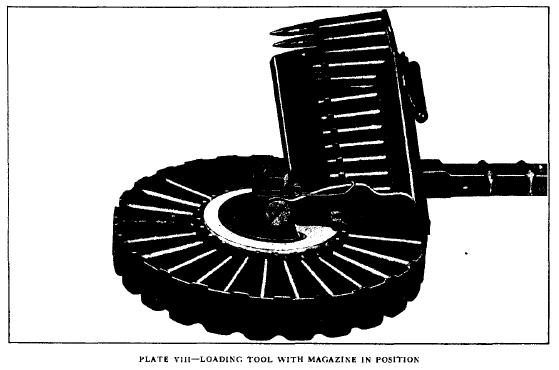Since I mentioned one of its contemporaries in the last post, I think this would be a good time to take a look at the Lewis gun. It was designed by an American (Colonel Isaac Lewis) in the early nineteen-teens, but he couldn’t get the rather stodgy ordnance department of the time to take an interest. So Lewis took the design to Europe instead, where he found the British government interested.
The Lewis was the first really successful light machine gun, being air-cooled and light enough for one man to move and use. What appears to be a huge barrel is actually a cooling shroud surrounding a finned aluminum radiator. The idea is that the gas expelled at the muzzle with each shot pulls air through the shroud, and that flow cools the gun. How effective or necessary the effect is can be debated, but the gun was certainly a success.
 A few other interesting features include a clock-type mainspring would into a toothed gear in place of a long coil spring, and magazines operated by mechanical cam instead of being spring loaded at all. Looking at a Lewis pan magazine for the first time, you’re likely to think you are seeing an incomplete one, as there is virtually no internal mechanism to the thing. Beyond that, the Lewis is a fairly typical gas piston operated design. It saw extensive use in both World Wars as a familiar ground gun and (less the cooling shroud) as a aircraft armament. For more detailed info, I would point you to the Model 1918 Lewis manual I have added to the Original Manuals page of the Vault:
A few other interesting features include a clock-type mainspring would into a toothed gear in place of a long coil spring, and magazines operated by mechanical cam instead of being spring loaded at all. Looking at a Lewis pan magazine for the first time, you’re likely to think you are seeing an incomplete one, as there is virtually no internal mechanism to the thing. Beyond that, the Lewis is a fairly typical gas piston operated design. It saw extensive use in both World Wars as a familiar ground gun and (less the cooling shroud) as a aircraft armament. For more detailed info, I would point you to the Model 1918 Lewis manual I have added to the Original Manuals page of the Vault:
Model 1918 Lewis gun manual (English)

Be the first to comment